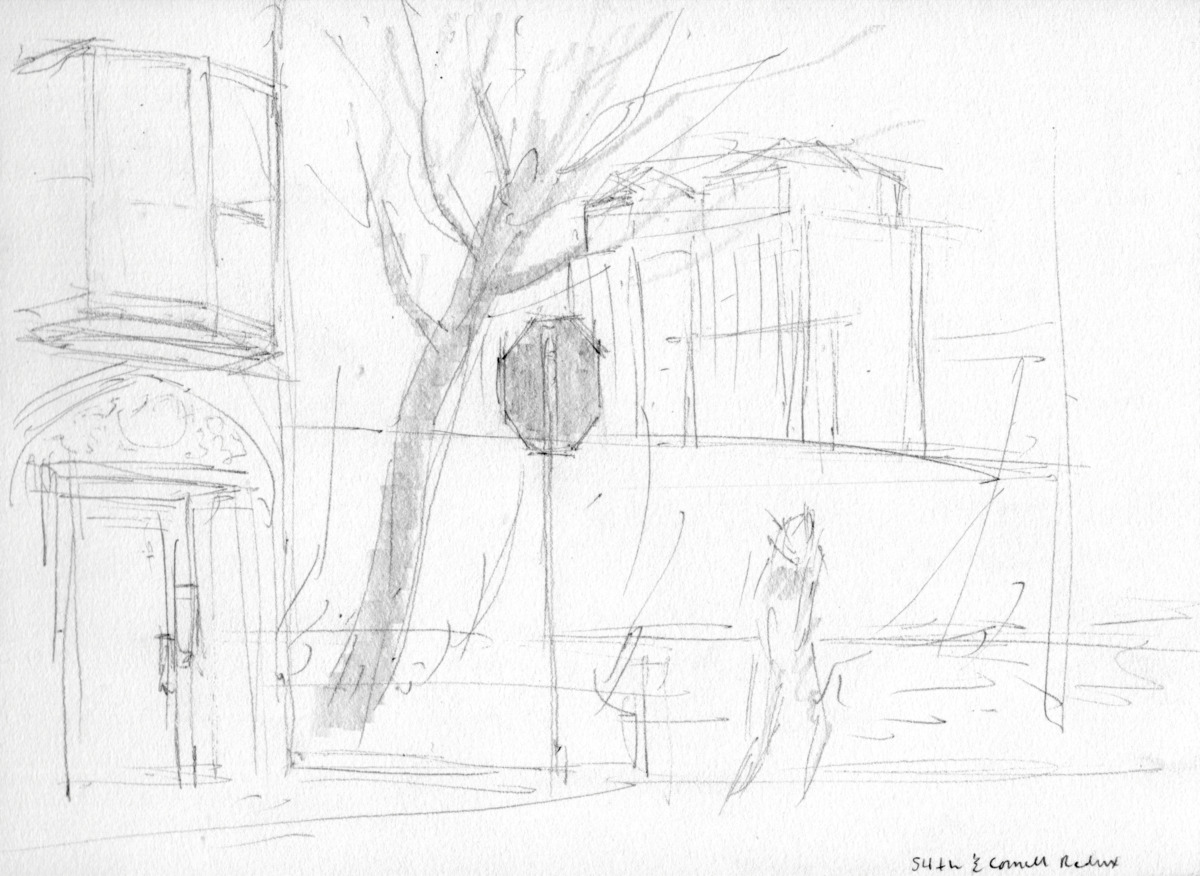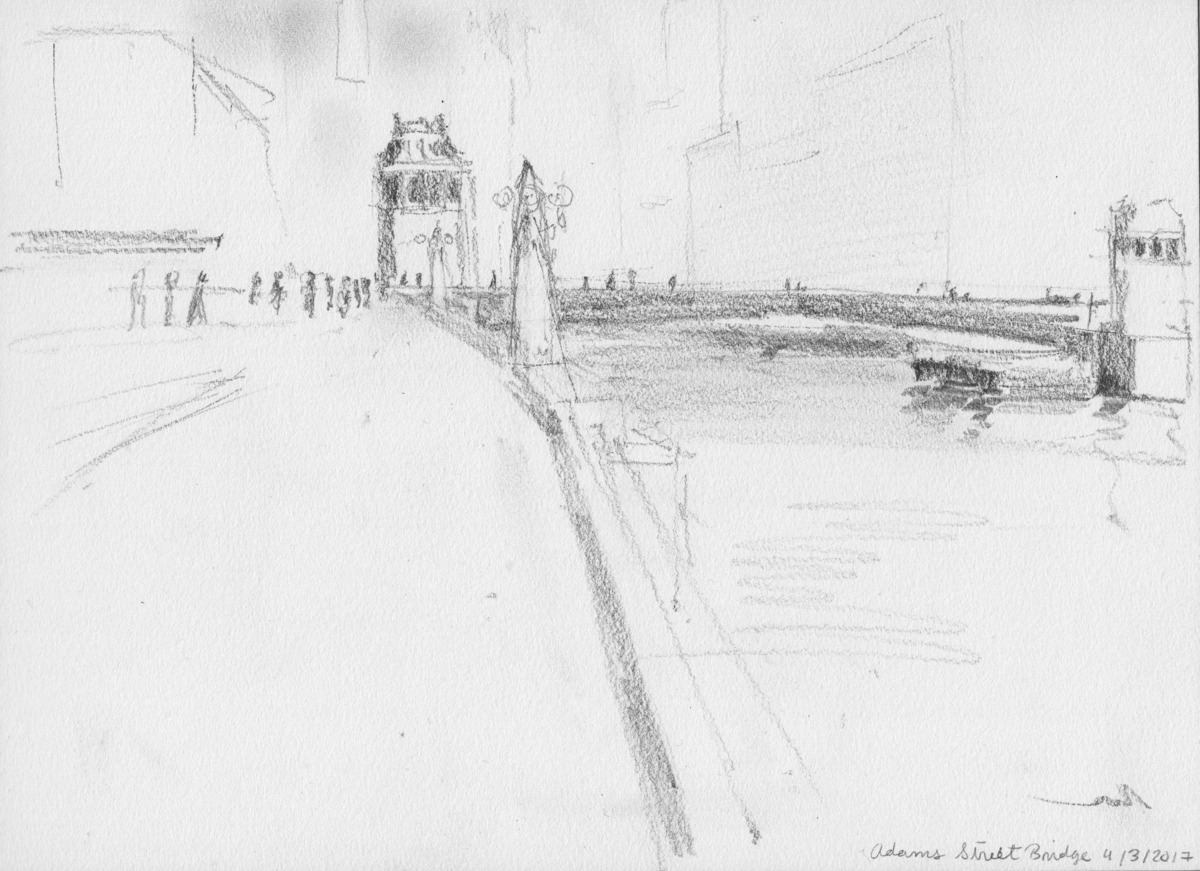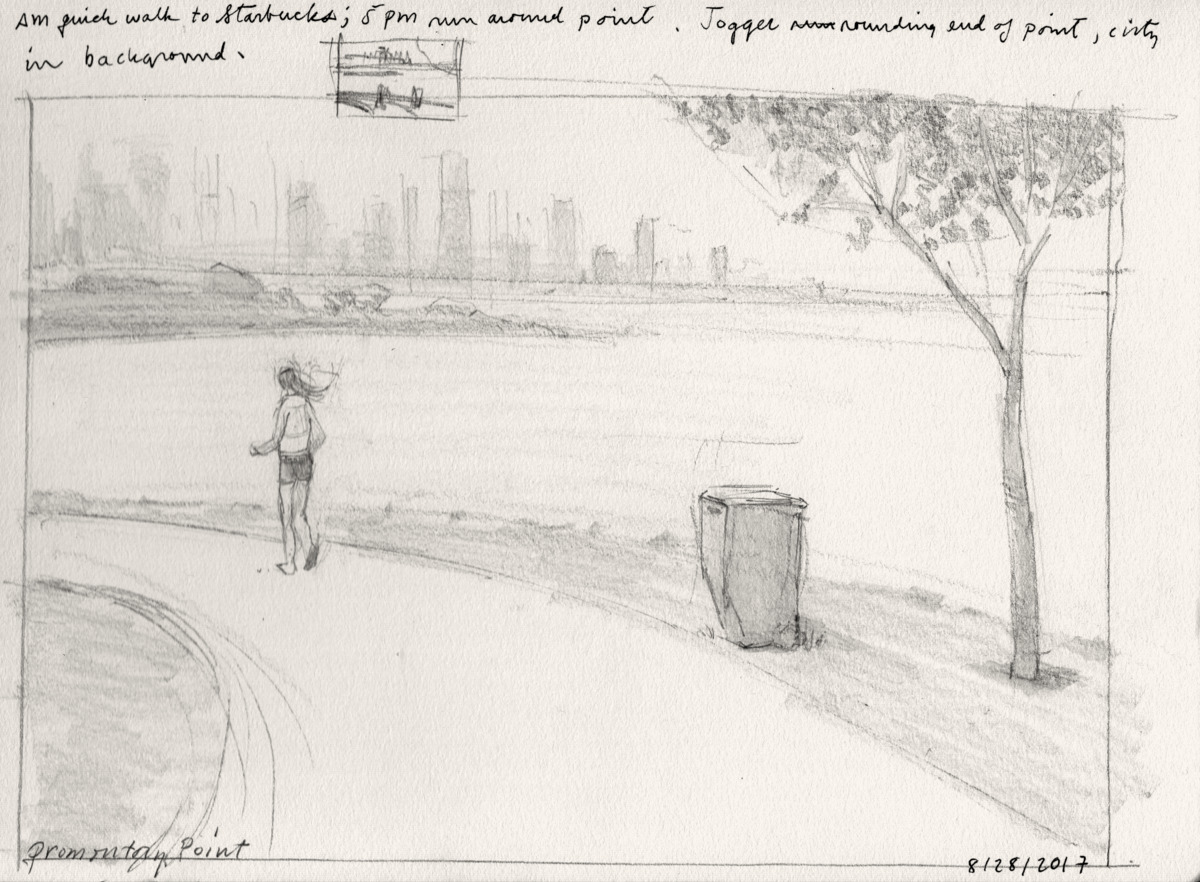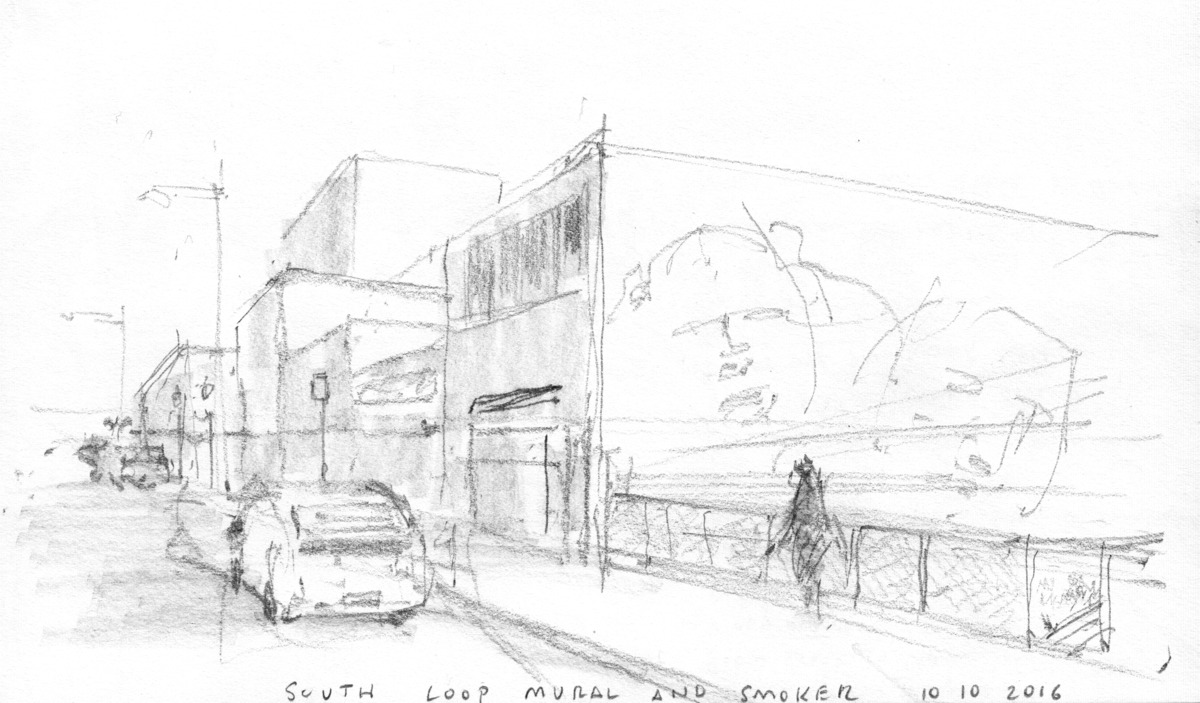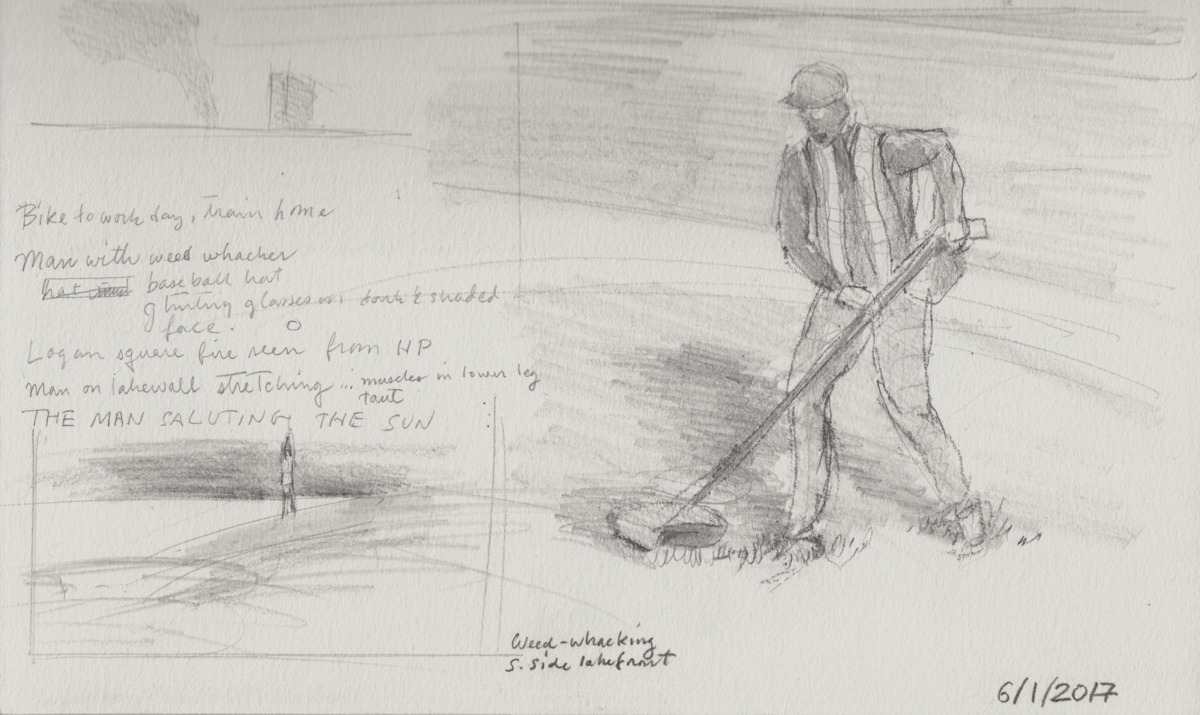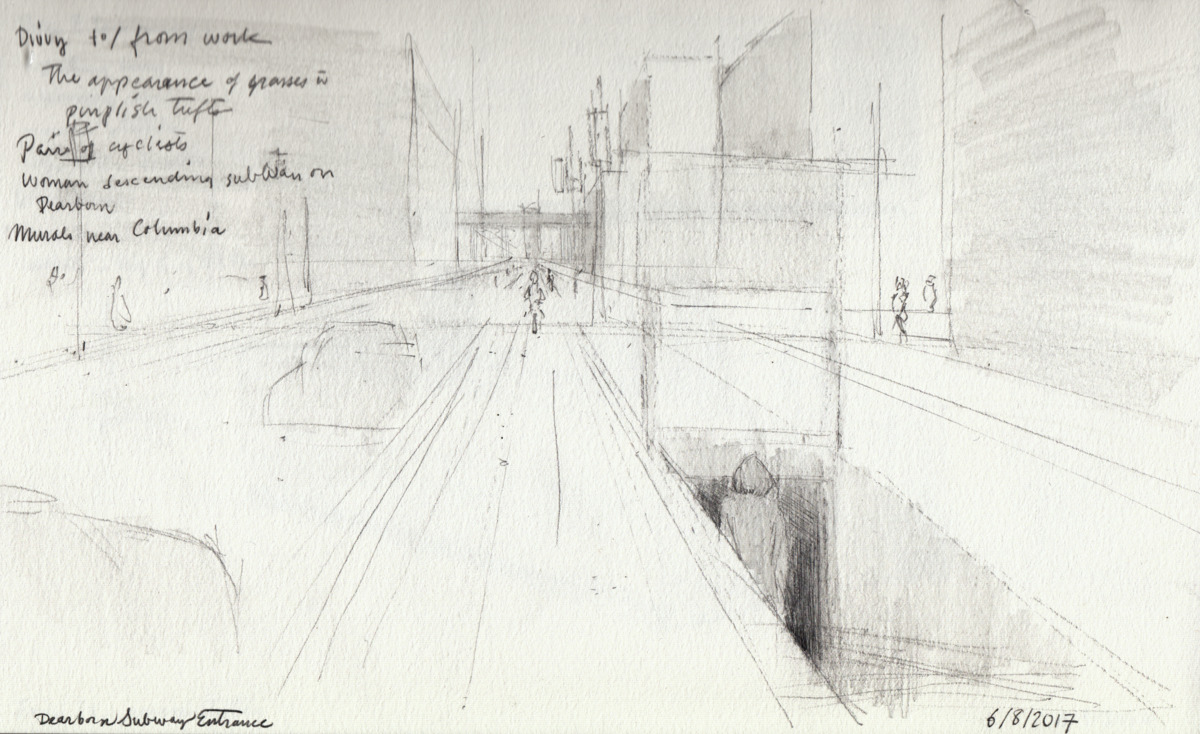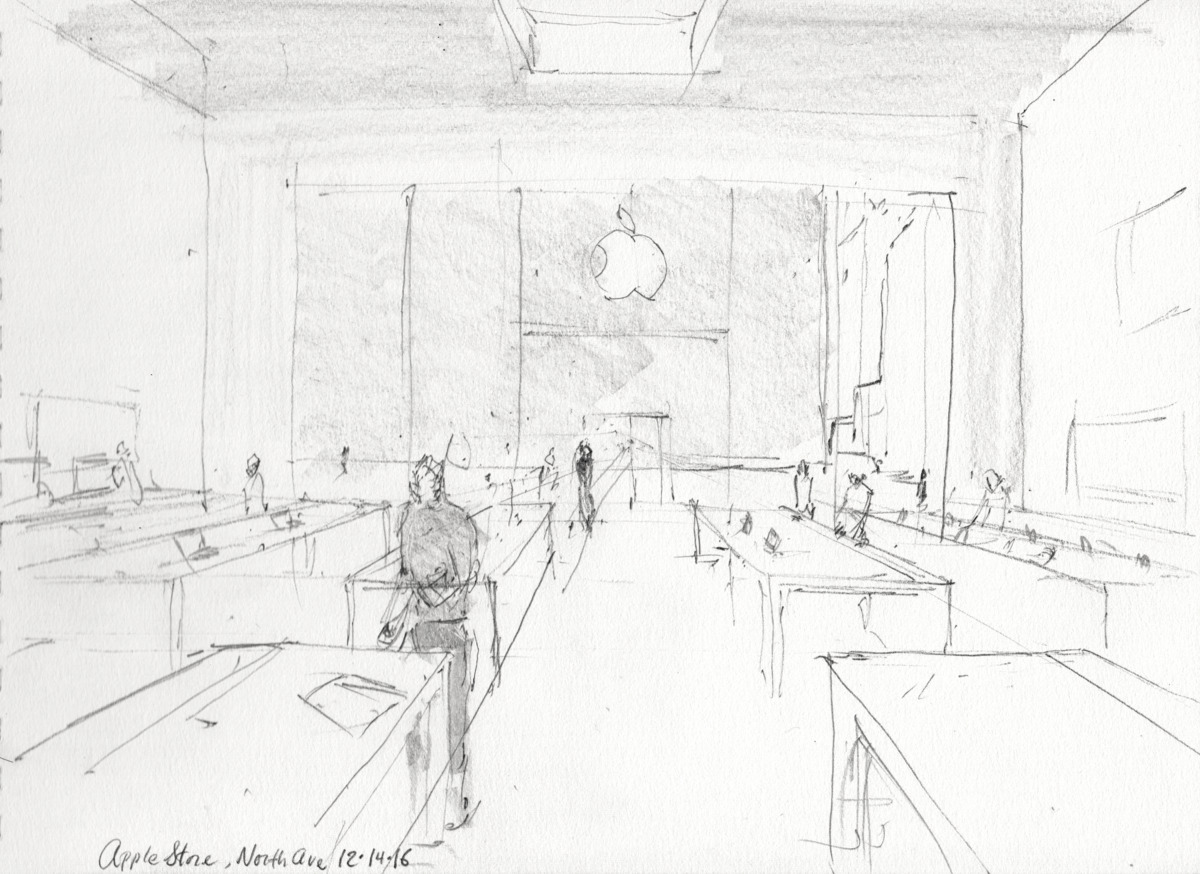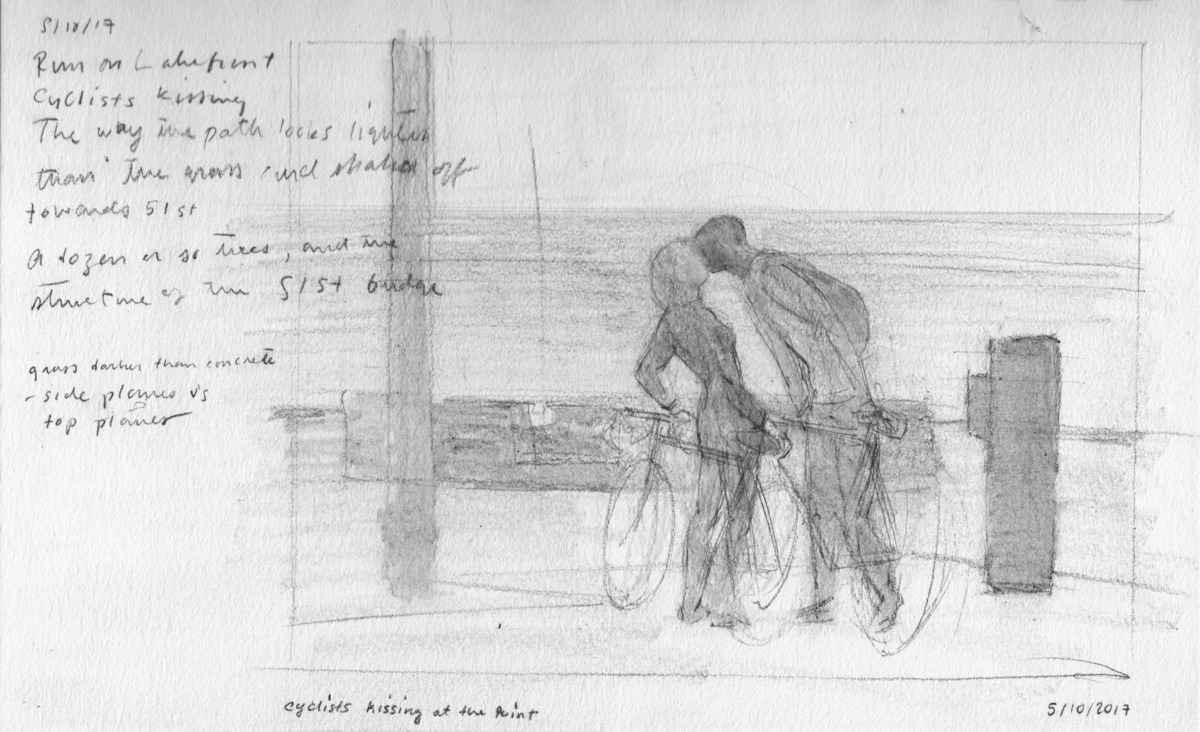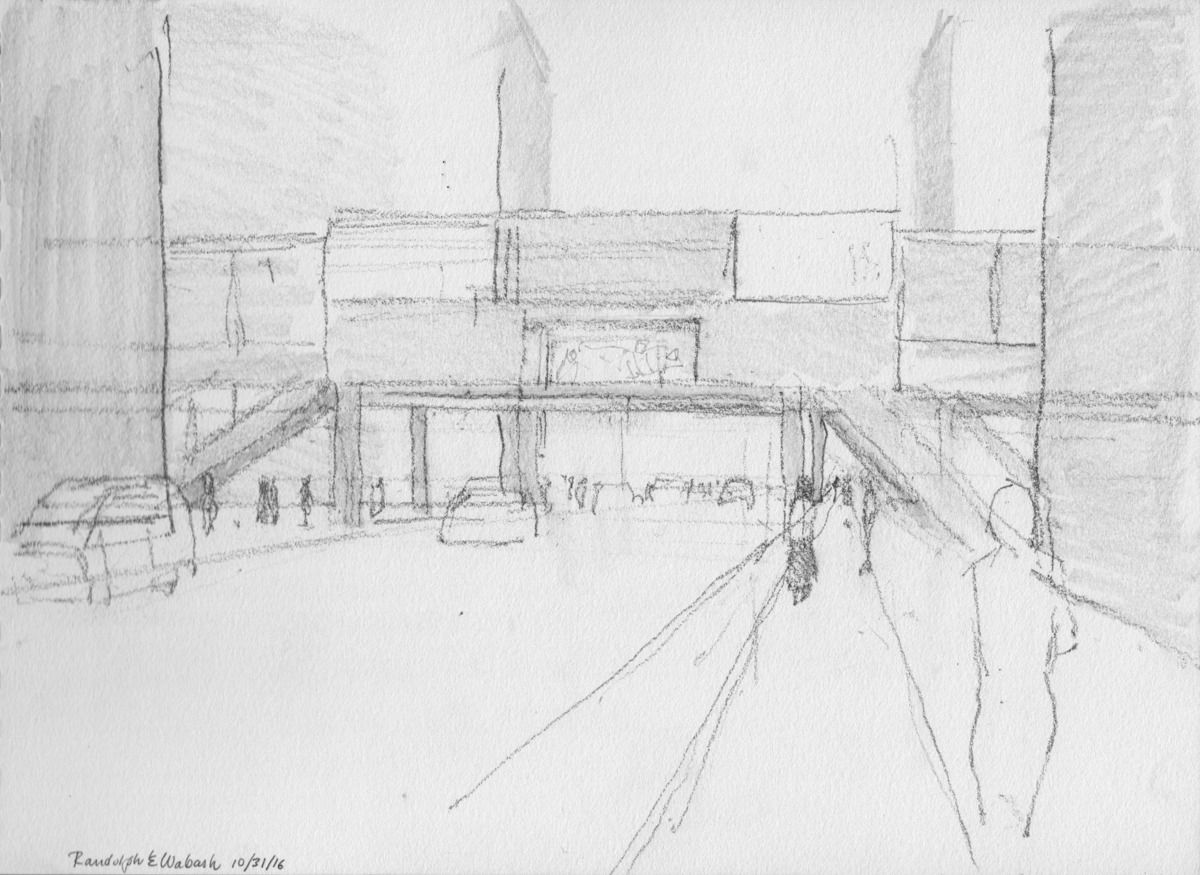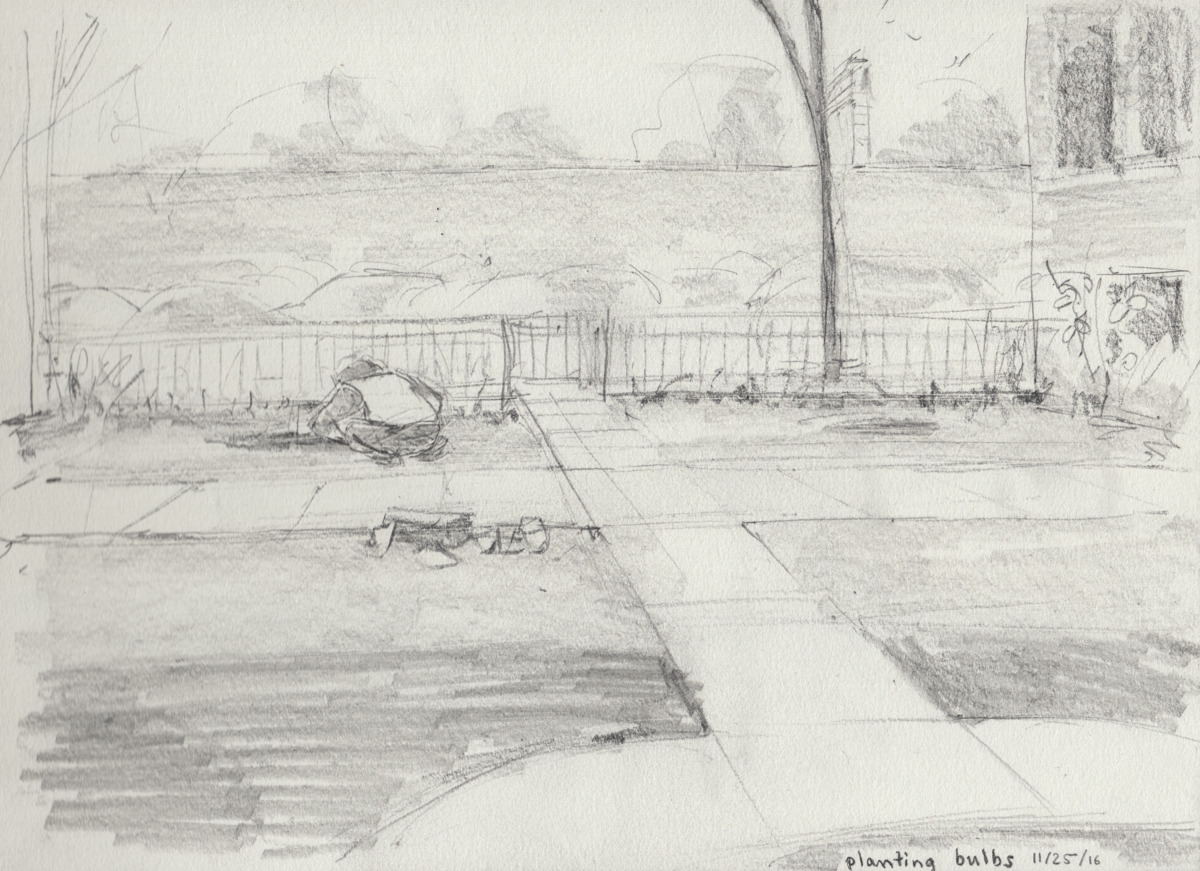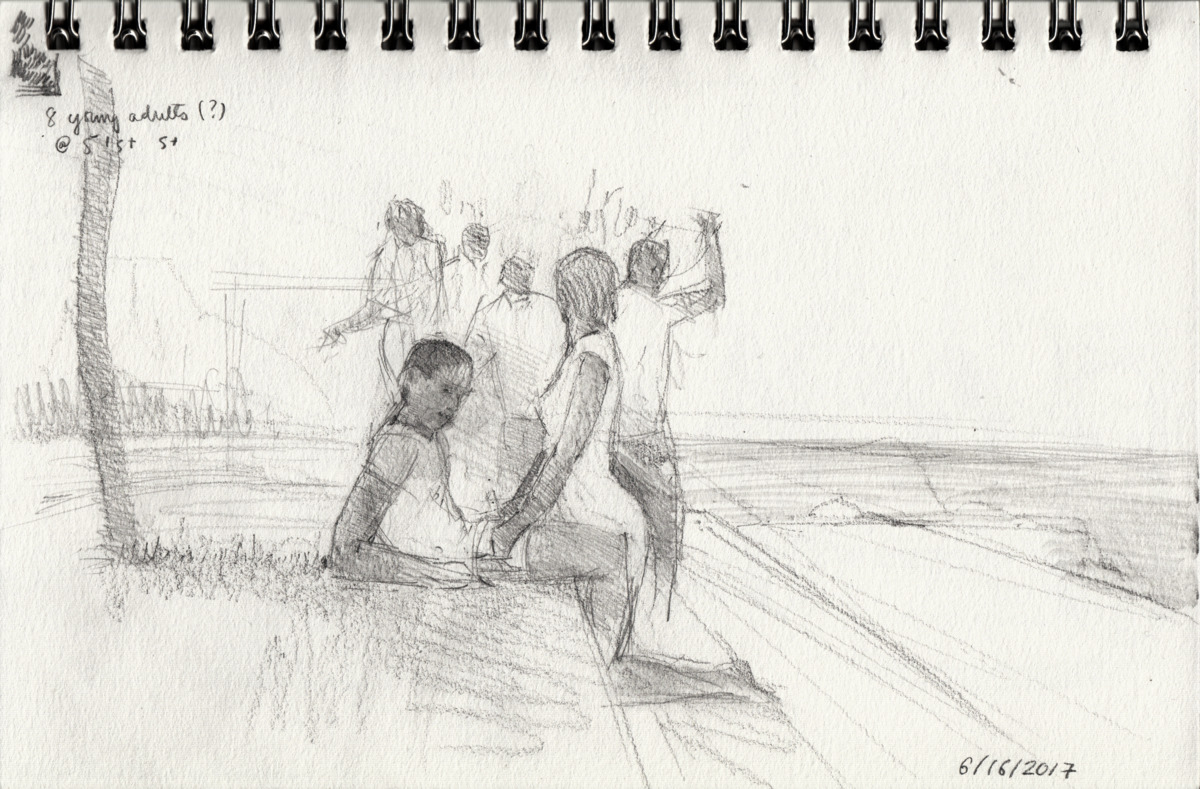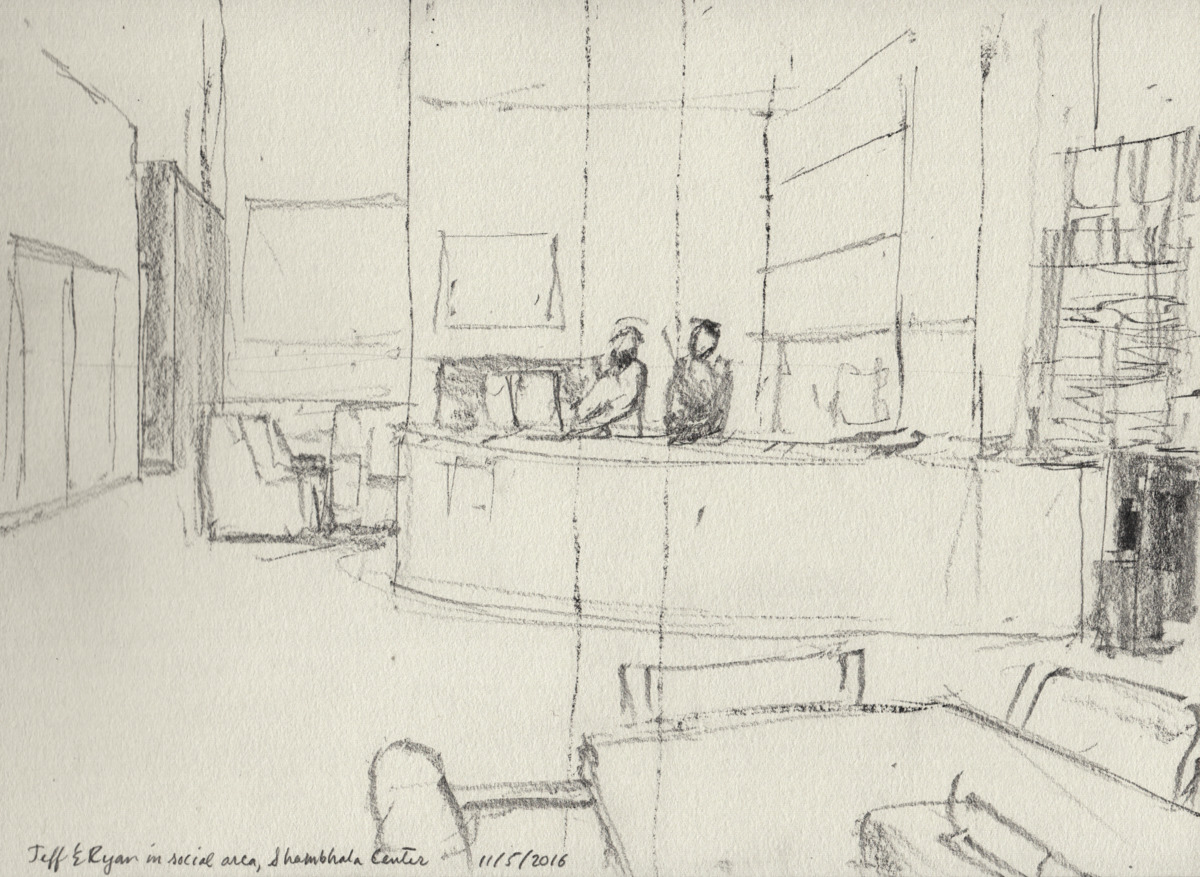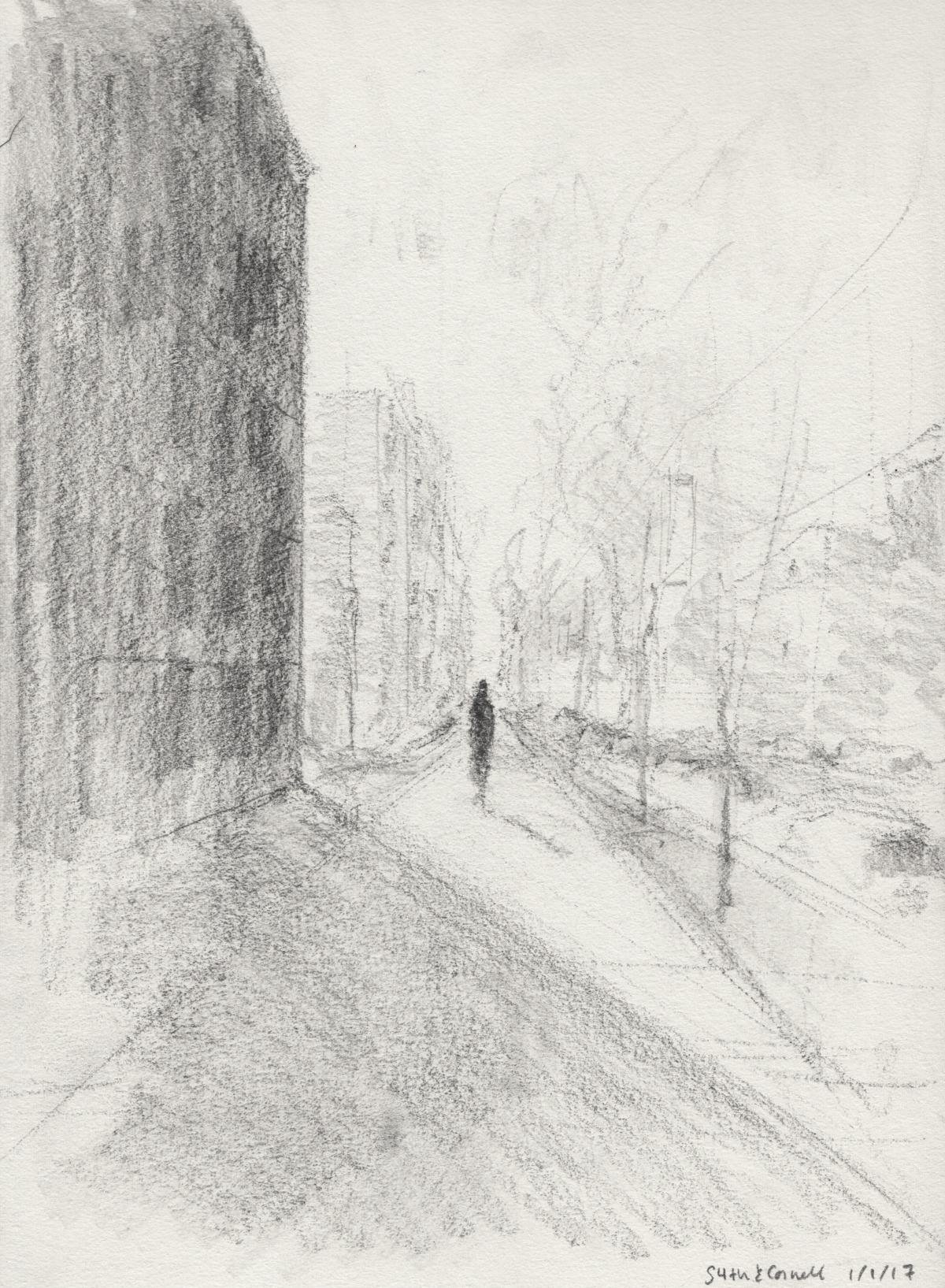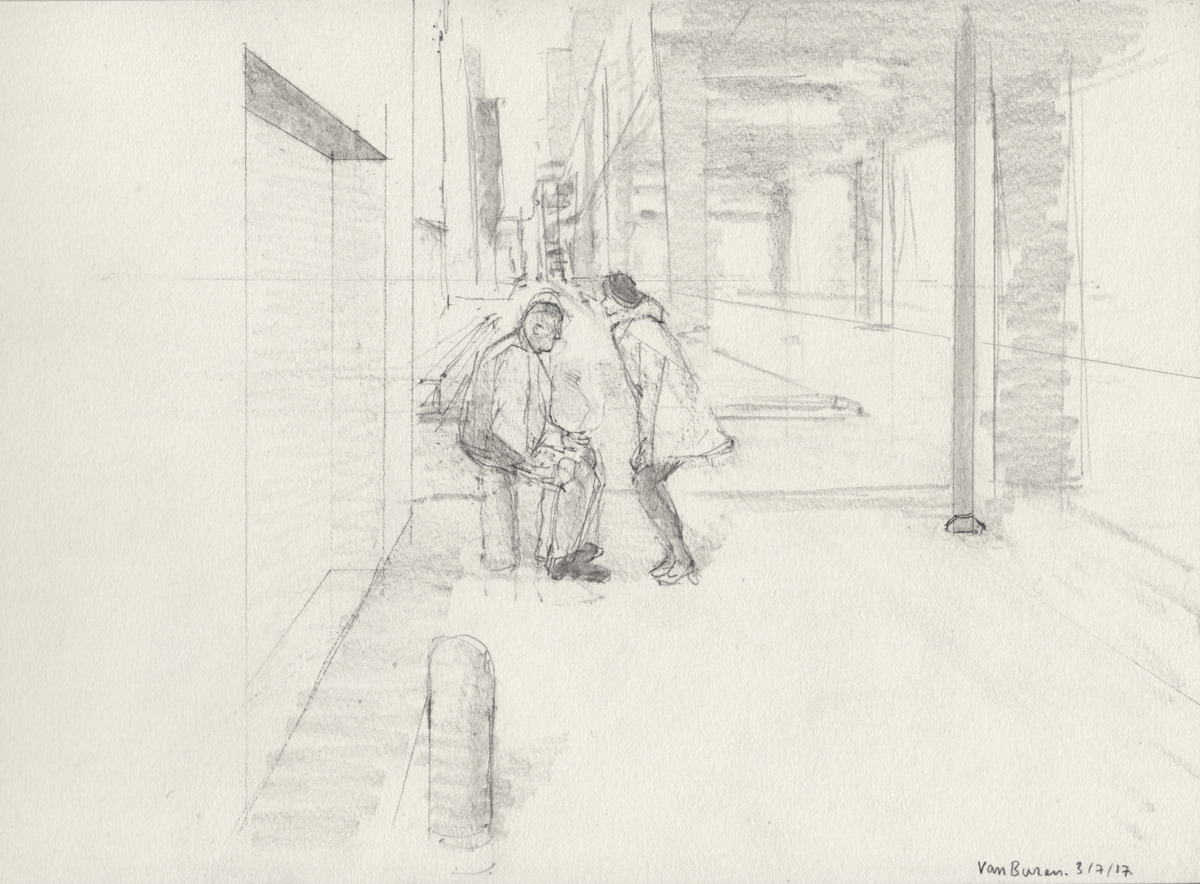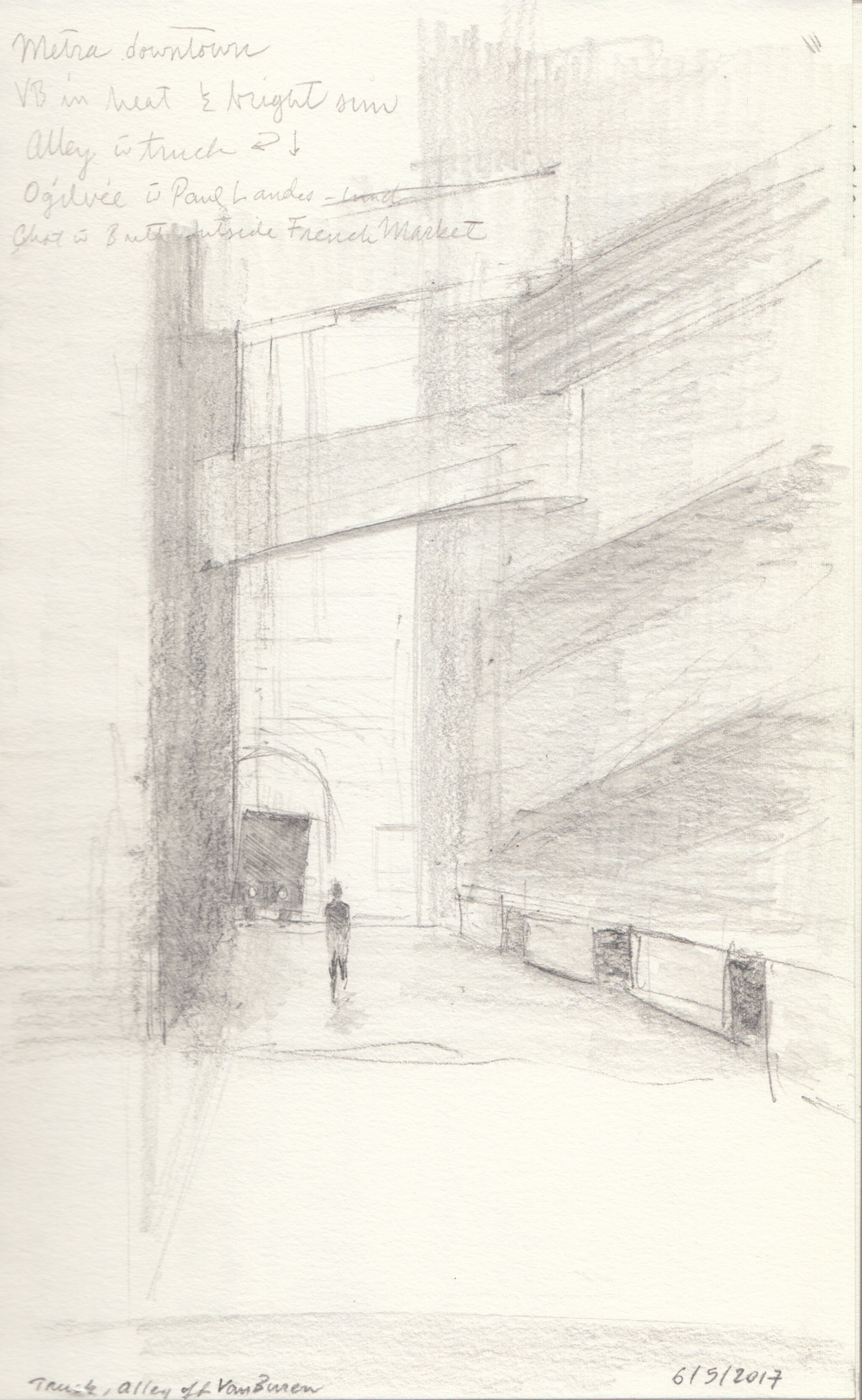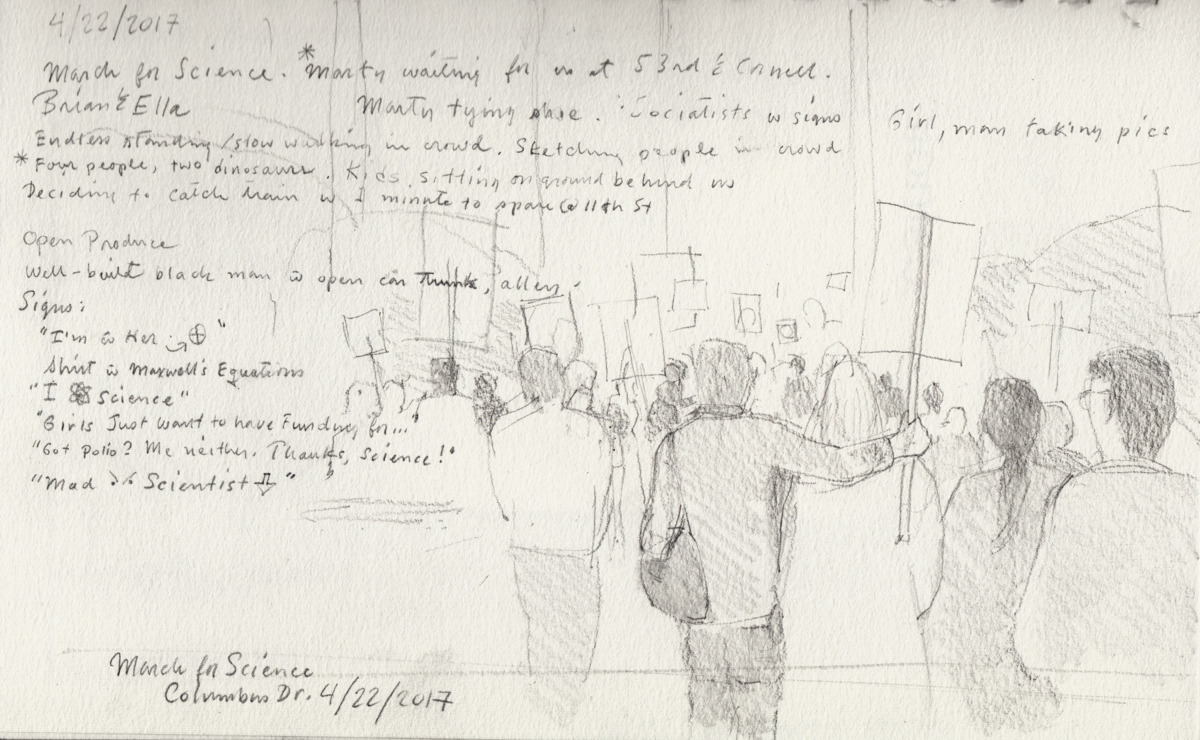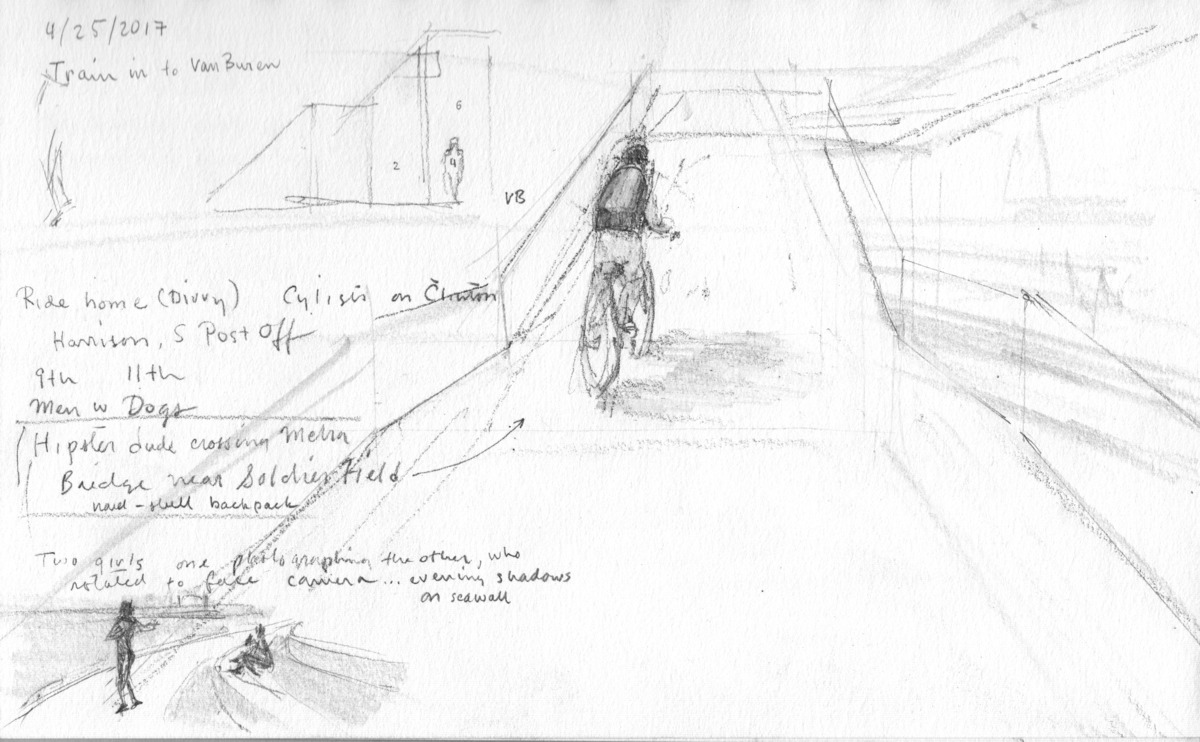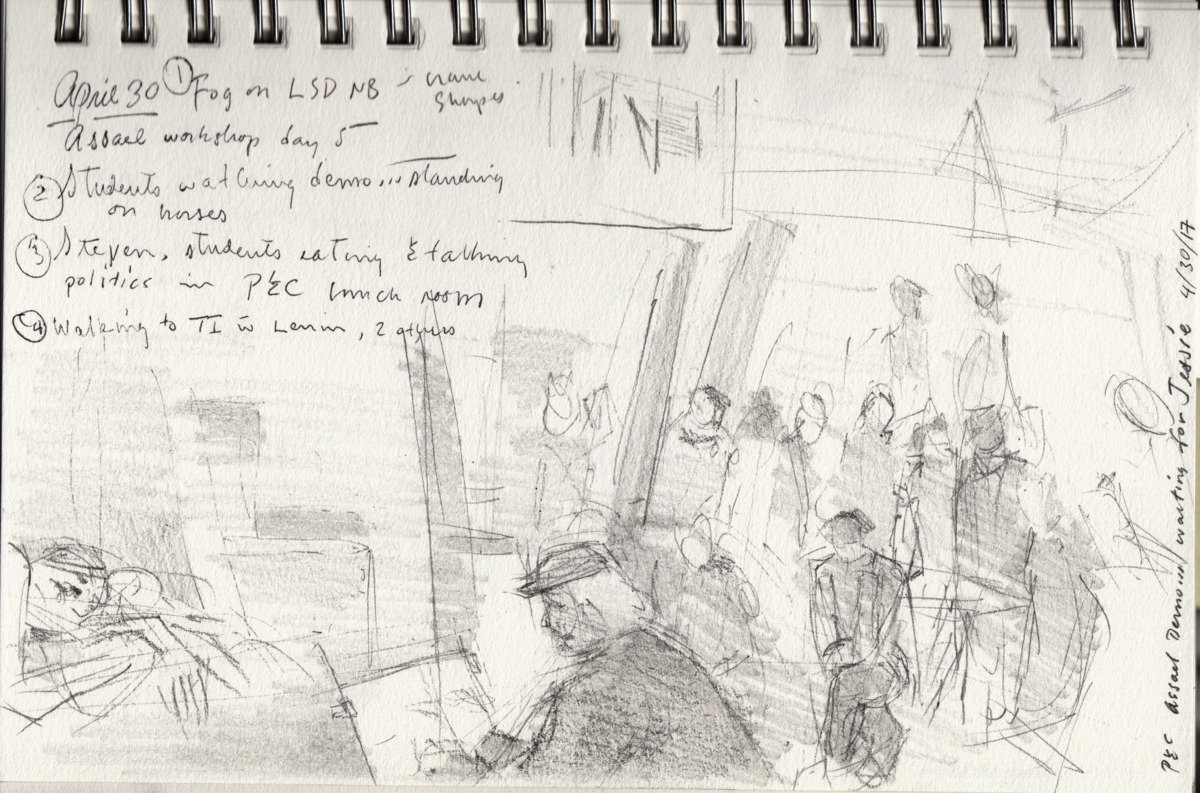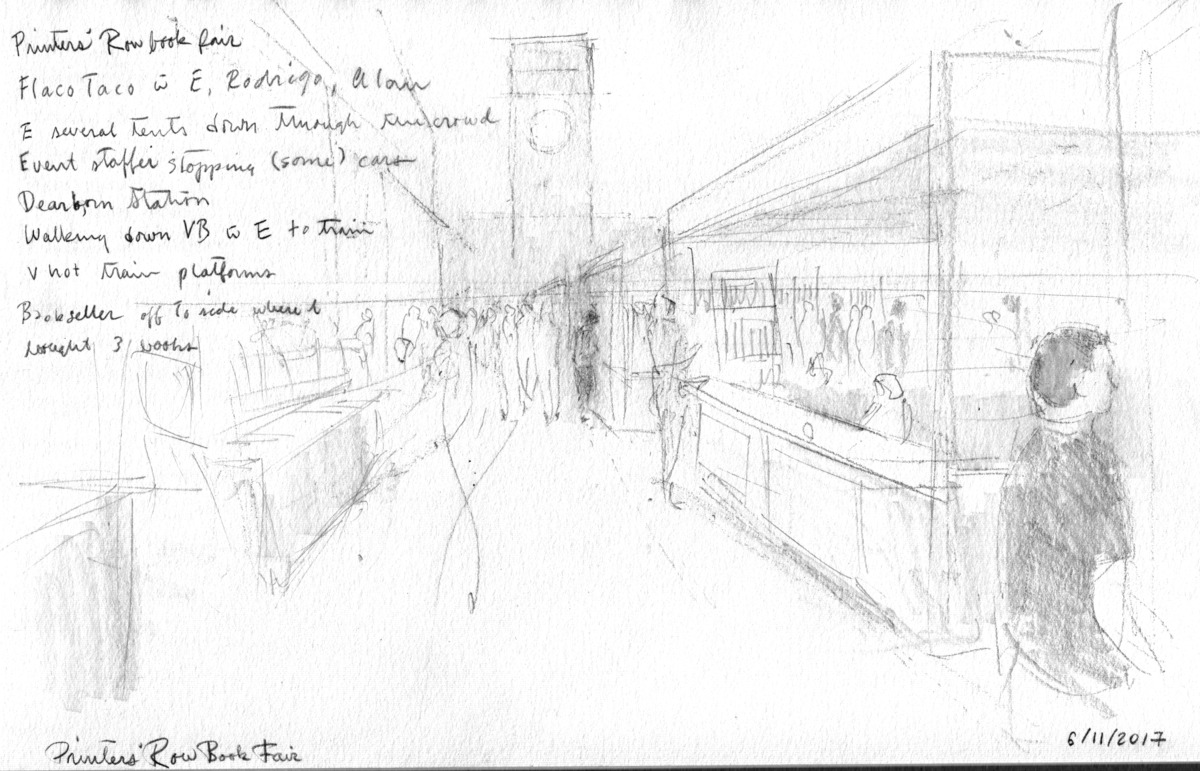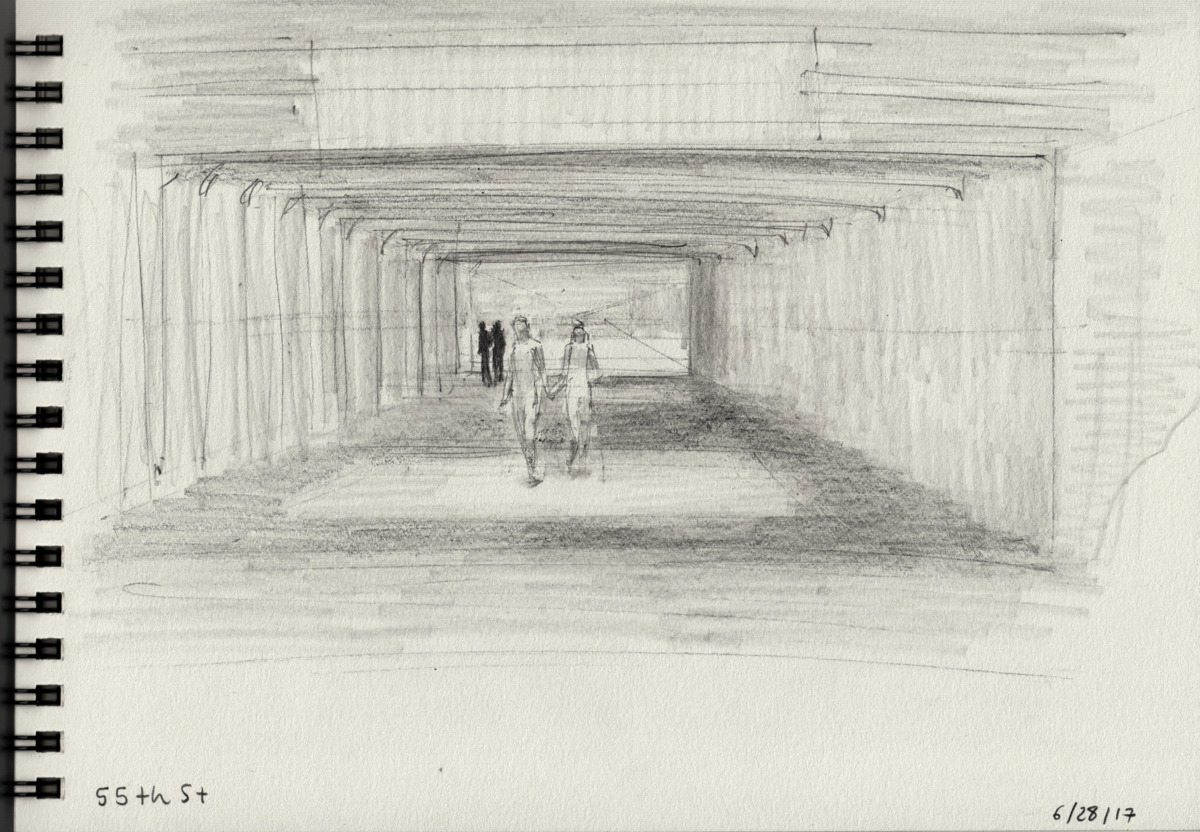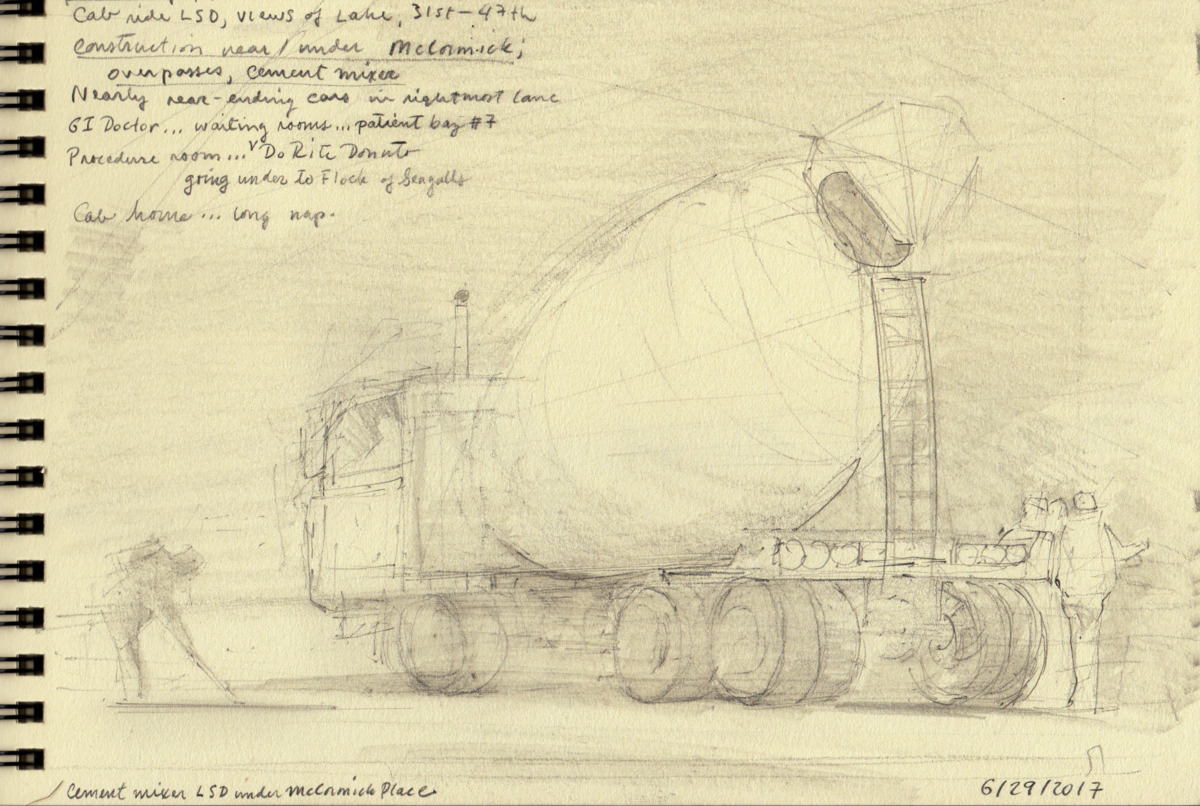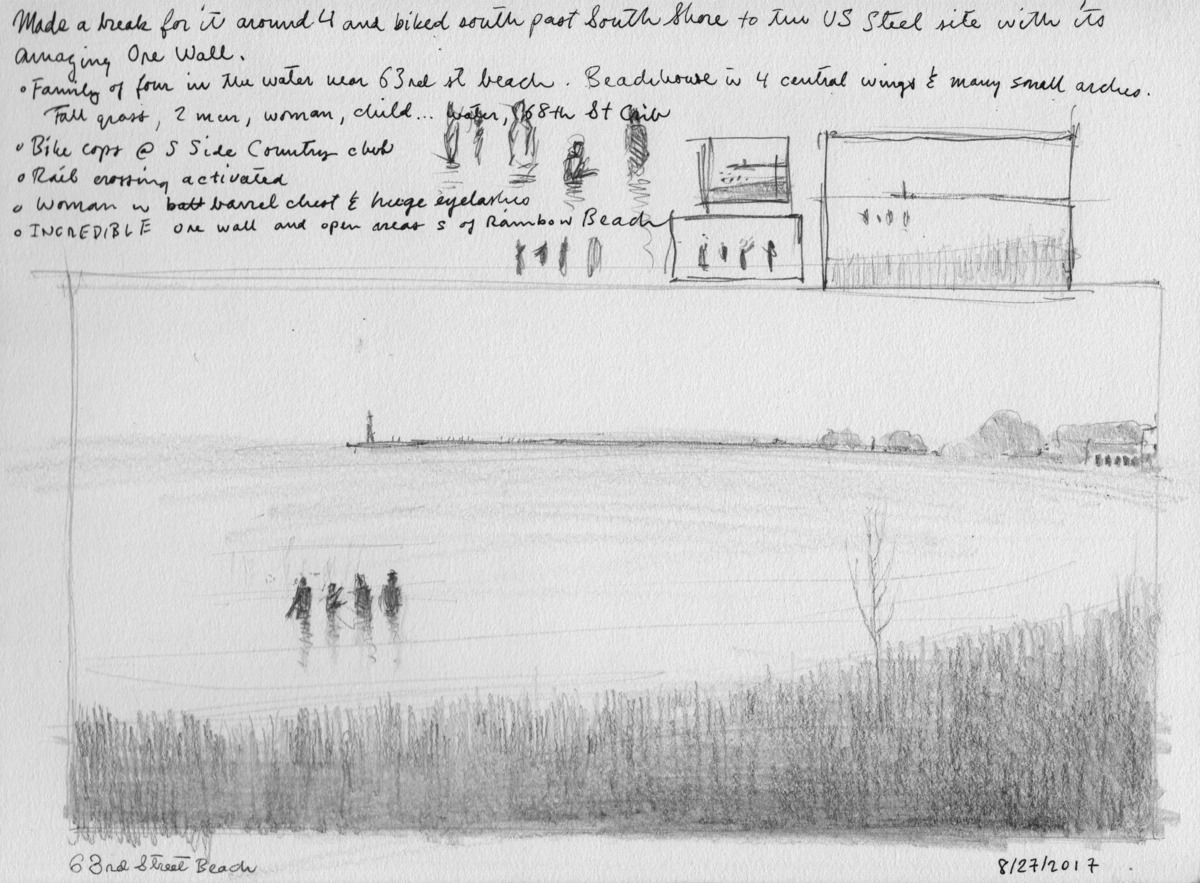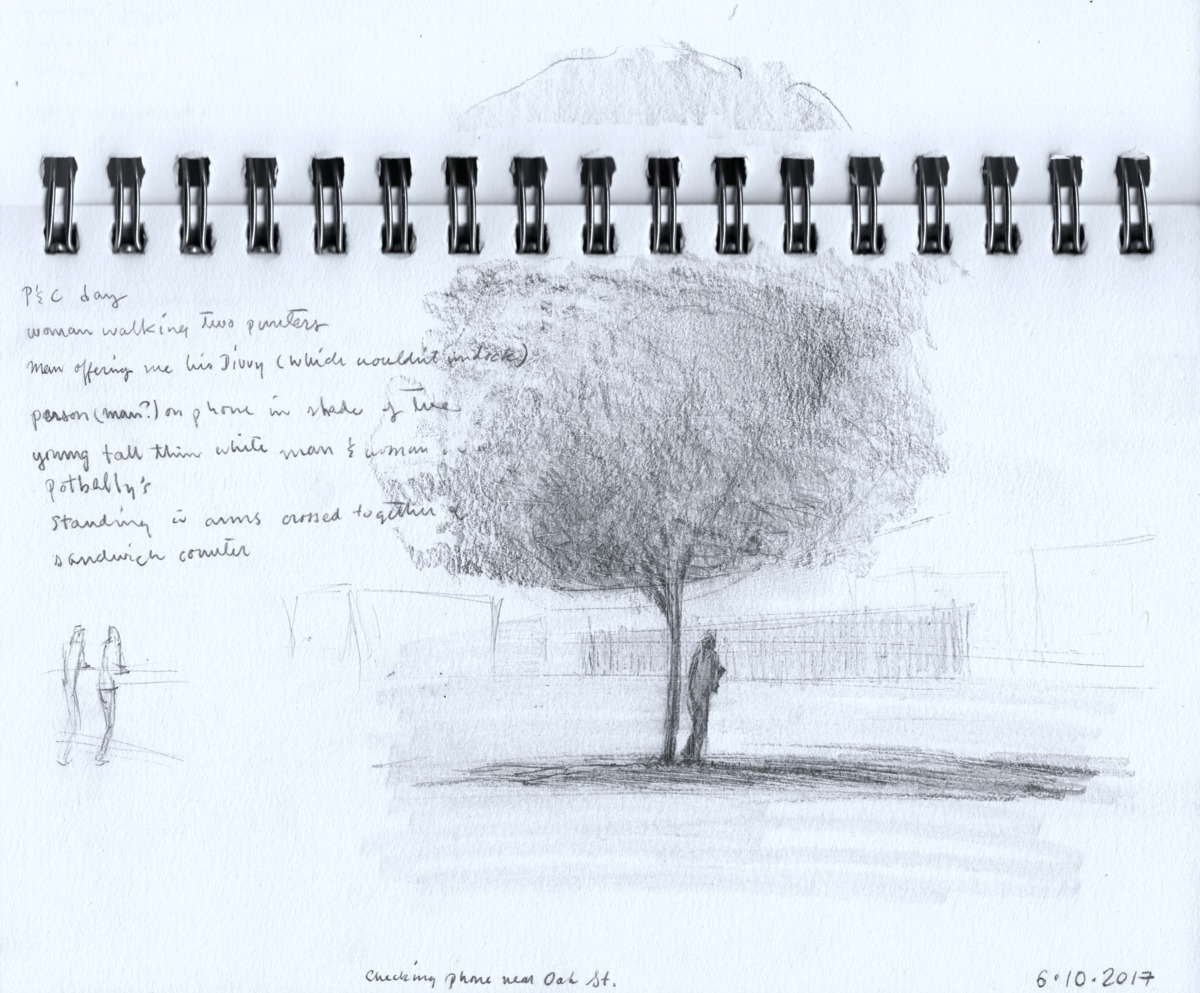Reflections on a Year of Daily Memory Drawings
art
Monday, September 18, 2017
365 Drawings
The sketchbooks shown below are the result of doing one drawing from memory every day for a year, a project I finished this month.
This drawing practice was based on the Daily Composition, which, as I explained last January, is an exercise from The Natural Way to Draw, by Kimon Nicolaïdes (published posthumously in 1941). The requirements for this exercise are as follows:
- See things and events that interest you throughout the day;
- Remember them, and
- Capture them on paper, in the form of a single image …
- … Once per day.
Each of these is challenging in its own way, and each reinforces the other. Maintaining the practice over a full year taught me a number of lessons.
Lesson 1: The limits of visual memory
I’d struggled with this exercise now and again over the years, and in taking it up again I was immediately reminded just how little I remember of what I see throughout the day.
The mind is able to recognize, and, to a greater or lesser extent, to respond mentally and emotionally to a stunning variety of objects and occurrences in the world around us. This happens automatically and without effort. But this sort of ordinary seeing is not the same as being able to recall and to visually reproduce the things we “see.”
To demonstrate this to yourself, try to draw your spouse’s face, or a friend’s, from memory. This is a person you would have no trouble recognizing, even at some distance, yet you don’t really have access to how your brain stores that information. Now try to draw your car, or bicycle, or the front of your building. These are things you know well, yet you probably cannot describe them visually in much detail.
Doing this exercise faithfully made this fact painfully obvious. Each day, out of the millions of details that passed in front of my eyes, I was left grasping only a handful of facts to work with at day’s end. (The number of memories was small, but I was surprised that it was never zero.)
Contrast this with the capabilities of a camera: it faithfully records the details it is exposed to, millions of bits of data per shot. But the camera, a mere machine, cannot recognize or react emotionally to those details1.
Lesson 2: Trying to remember amplifies seeing
It would be easy to think of the Daily Composition exercise as a way of learning how to do a camera’s job: you are exposed to scenes, and later you record them on paper. I did find myself, in fact, taking mental “pictures” most days, of a person or group doing something, in some specific place. I would see a person getting into a cab, or construction workers huddled over a hole, or (one day) a unicycle rider cresting a small hill, and I would think, “that’s it!” and try to remember, for that evening’s drawing, everything I could about the moment I’d just seen.
During the course of the year, I didn’t actually get that much better in terms of the sheer number of details I could recall. A half dozen “facts” (the size and shape of a doorway; the size and number of windows in a storefront; the particular shape of a woman’s boots), along with a rough gesture for and/or placement of the key figures, were about as I could expect for any given day’s drawing.
A much bigger change occurred in my ability to notice things, and my emotional response to them was amplified. Knowing that I needed material for a drawing at the end of the day simply opened my eyes more. It was like going on vacation somewhere totally new. I saw things in my neighborhood, and on my commute, that I had passed by without noticing for years: the shapes and placement of signs, light poles, fire hydrants; the construction and weathering of steel supports for elevated trains; the multitudes of ornamental details on buildings. The endless variety of people’s faces… commuters, shopkeepers, construction workers, homeless men and women; the smiles, grim stares (especially at commute times) or lines of care they bore; their postures and gestures (all too often, in relationship to their phones); the cut and fit of their clothing, coats, boots or shoes. The endless repetitive movements of pigeons, and the surprising variety of other birds (sparrows, hawks, cranes, herons, geese, ducks, swallows, and several migratory bird species I couldn’t identify). The printed word, in steel or brass relief, to be seen everywhere in streets and sidewalks, indicating lines of survey, or the origin or builders of utility covers or nearby buildings. All the endless varieties of trees, contours of trunks, branching patterns, leaves, and all the grasses, flowers and weeds of the city… these things came to my notice, were revealed fresh as though I had previously had some sort of screen over my vision that had fallen away.
Part of seeing these things became caring about them. In that regard I became less, not more, like a camera.
Lesson 3: Emotion aids recall
If I saw something I reacted to emotionally, it was usually a lot easier to recall later. This seems obvious, but to live the connection between emotion and memory as part of one’s daily routine for a year had a cumulative effect. This is what I meant when I said in my last post that I felt a stronger connection to Chicago and my surroundings. I suspect that building these sorts of connections to daily life is one of the main reason Nicolaïdes recommends the exercise as a daily practice.
Lesson 4: Other tricks for remembering
Aside from focusing on things that give an emotional charge, here are some more tricks I used to remember things I saw:
- Practice drawing or painting something while you look at it. This includes making movements in the air as if you were drawing, building a little actual muscle memory (and inviting curious glances from passersby).
- Re-remember things. If I saw something I wanted to “save up” for the evening’s drawing, then whenever I saw something else that looked interesting, I would look carefully at it, but then I would use the whole noticing-something-noteworthy experience as a reminder to remember the other thing I was trying to remember also. In other words, every new thing I noticed became a reminder to remember the other thing. Occasionally, I would build a list of things to remember and would then go through the list items one-by-one whenever this occurred.
- De-distract and focus. Of course, sometimes the above tricks got to be too much; at those times, I’d try to minimize my visual input by looking down at the sidewalk if safe to do so (allowing my peripheral vision or looking up when needed, in order to keep from getting hit by buses, etc.), just making the effort to hold the memories in my mind while I walked or ran.
Lesson 5: Invention and knowledge help fill in details
Given a relative paucity of remembered facts, how do you complete your drawing? Just as our mind fills in details about what we see without our being consciously aware of it, one can invent the elements of a scene that elude our grasp when we try to recall them. For this, a knowledge of perspective, of human anatomy and clothing, of the construction of builings and plants and trees, and especially of light and shadow are indispensible for adding extra life and believability to a composition, no matter how quickly executed. For example, I would rarely remember a specific shadow, but if I knew where I was and what time it was, I could place the shadows based on where the sun would have been at the time. Used skillfully, invention can also amplify whatever emotional response led one to record the scene in one’s mind to begin with.
I think I got slightly better at “filling in the gaps” this way over the year. The exercise does seem to strengthen the connection between memory, knowledge, and imagination.
Lesson 6: Drawing can distort memory; revisiting a place helps
I often noticed that, after drawing something that occurred in a specific place, my memory would be strongly affected by whatever inventions (or mistakes) I came up with to compensate for my ignorance of the drawing’s setting. For this reason, I sometimes disliked looking at the drawings after the fact because they were so clearly wrong and they interfered with my “real” memory of where the event occurred. An easy remedy for this was just to go back to the place in question and look around. One sees many more details the second time around, and it’s always amusing and humbling to realize how wrong you got it the first time.
On a related note, I find that taking and reviewing photographs shapes my memory as well. I remember things differently, and more emotionally, having drawn them, either from life or from memory, than I do when I’ve photographed them. I sometimes limit my photography when I travel for this reason (although I still take a ton of pictures).
Lesson 7: Don’t make it a big deal
To do the exercise three hundred and sixty five days in a row did require commitment, since I have a busy schedule and was generally doing it at the end of the day when my willpower budget and my ability to focus were all but spent.
Nicolaïdes makes a point of not making a big deal of these drawings, setting a fifteen minute time limit for each. I broke this rule many times, especially at the beginning when I would try to recall as much as possible. Eventually, however, I settled for just jotting down a few things I remembered seeing (sometimes starting with just remembering where I was and what I did, which could be hard enough), and turning the most compelling memory into a small composition. Even on days when I was the most busy and distracted I could typically remember at least one thing to put down on paper. And I found there was only a loose correlation between how much effort I put into remembering things throughout any given day, and how much I liked the drawing at the end of that day. Some days I was excited about the results, and some days I was just happy to put the drawing away afterward. Part of what’s good about doing something like this is you can fail over and over again, and your daily commitment to the practice means that any specific failure is no big deal.2
Lesson 8: More can be better
At least half the drawings are so bad, I find them pretty painful to look at now. Many of them show an interesting tidbit or idea worth developing further. And a small fraction, less than 10%, I enjoy looking at and find appealing on their own terms. Some of these are shown here.
The few successes illustrate an important rule that I still struggle with: with art making, sometimes quantity wins. I prefer to work for a long time on paintings, but it is nice to complete something every day and, occasionally, to have it succeed. No matter who you are, I suspect if you make a drawing a day for a whole year, at least a few of them will suprise and please you.
Lesson 9: It’s about composition
Composition is about choosing what goes in a picture and arranging those things in a pleasing design which communicates one’s ideas or intentions. One reason I took up this practice is that I find inventing compositions (e.g., in the studio) more challenging than finding them directly in front of me. Ultimately, memory and rendering are only part of the practice… the rest (perhaps the biggest part) is design. Nearly four hundred drawings later I still find it challenging, but solving a specific design problem every night has made the whole problem of composition seem tractable in a way it didn’t before. This, I imagine, was another reason Nicolaïdes emphasized this exercise.
Moving forward
It will be helpful if you keep this up for a year, and it will be twice as helpful if you keep it up for two years. The really serious student will make a quick composition every day for the rest of his life despite everything else he has to do. –Nicolaïdes
In later chapters of The Natural Way to Draw, variations on the Daily Composition are introduced, including a greater amount of invention, and revisiting the same scene over several days in an extended composition. For myself, I wanted the challenge of working primarily from memory for a year, but have increasingly been craving more time for both invention and for working from life. I intend to continue regular compositional practice, but more as a natural and playful part of my creative rhythm, rather than as a tightly-defined daily practice. I don’t know where it will lead, but look forward to finding out.
More Drawings
Here are a few more drawings from the year.
Footnotes:
Blog Posts (170)
Select from below, view all posts, or choose only posts for:art clojure code emacs lisp misc orgmode physics python ruby sketchup southpole writing
From Elegance to Speed code lisp clojure physics Wednesday, September 25, 2019
Common Lisp How-Tos code lisp Sunday, September 15, 2019
Implementing Scheme in Python code python lisp Friday, September 13, 2019
A Daily Journal in Org Mode writing code emacs Monday, September 2, 2019
Show at Northwestern University Prosthetics-Orthotics Center art Saturday, October 20, 2018
Color Notations art Thursday, September 20, 2018
Painting and Time art Tuesday, May 29, 2018
Learning Muscular Anatomy code clojure art emacs orgmode Thursday, February 22, 2018
Repainting art Sunday, May 14, 2017
Daily Memory Drawings art Tuesday, January 3, 2017
Questions to Ask art Thursday, February 25, 2016
Macro-writing Macros code clojure Wednesday, November 25, 2015
Time Limits art Saturday, April 25, 2015
Lazy Physics code clojure physics Thursday, February 12, 2015
Fun with Instaparse code clojure Tuesday, November 12, 2013
Nucleotide Repetition Lengths code clojure Sunday, November 3, 2013
Updating the Genome Decoder code clojure Saturday, July 13, 2013
Getting Our Hands Dirty (with the Human Genome) code clojure Wednesday, July 10, 2013
Validating the Genome Decoder code clojure Sunday, July 7, 2013
A Two Bit Decoder code clojure Saturday, July 6, 2013
Exploratory Genomics with Clojure code clojure Friday, July 5, 2013
Rosalind Problems in Clojure code clojure Sunday, June 9, 2013
Introduction to Context Managers in Python code python Saturday, April 20, 2013
Processes vs. Threads for Integration Testing code python Friday, April 19, 2013
Resources for Learning Clojure code clojure Monday, May 21, 2012
Continuous Testing in Python, Clojure and Blub code clojure python Saturday, March 31, 2012
Programming Languages code clojure python Thursday, December 22, 2011
Milvans and Container Malls southpole Friday, December 2, 2011
Oxygen southpole Tuesday, November 29, 2011
Ghost southpole Monday, November 28, 2011
Turkey, Stuffing, Eclipse southpole Sunday, November 27, 2011
Wind Storm and Moon Dust southpole Friday, November 25, 2011
Shower Instructions southpole Wednesday, November 23, 2011
Fresh Air and Bananas southpole Sunday, November 20, 2011
Traveller and the Human Chain southpole Thursday, November 17, 2011
Reveille southpole Monday, November 14, 2011
Drifts southpole Sunday, November 13, 2011
Bon Voyage southpole Friday, November 11, 2011
A Nicer Guy? southpole Friday, November 11, 2011
The Quiet Earth southpole Monday, November 7, 2011
Ten southpole Tuesday, November 1, 2011
The Wheel art Wednesday, October 19, 2011
Plein Air art Saturday, August 27, 2011
ISO50 southpole art Thursday, July 28, 2011
SketchUp and MakeHuman sketchup art Monday, June 27, 2011
In Defense of Hobbies misc code art Sunday, May 29, 2011
Closure southpole Tuesday, January 25, 2011
Takeoff southpole Sunday, January 23, 2011
Mummification southpole Sunday, January 23, 2011
Eleventh Hour southpole Saturday, January 22, 2011
Diamond southpole Thursday, January 20, 2011
Baby, It's Cold Outside southpole Wednesday, January 19, 2011
Fruition southpole Tuesday, January 18, 2011
Friendly Radiation southpole Tuesday, January 18, 2011
A Place That Wants You Dead southpole Monday, January 17, 2011
Marathon southpole Sunday, January 16, 2011
Deep Fried Macaroni and Cheese Balls southpole Saturday, January 15, 2011
Retrograde southpole Thursday, January 13, 2011
Three southpole Wednesday, January 12, 2011
Transitions southpole Tuesday, January 11, 2011
The Future southpole Monday, January 10, 2011
Sunday southpole Sunday, January 9, 2011
Radio Waves southpole Saturday, January 8, 2011
Settling In southpole Thursday, January 6, 2011
Revolution Number Nine southpole Thursday, January 6, 2011
Red Eye to McMurdo southpole Wednesday, January 5, 2011
That's the Way southpole Tuesday, January 4, 2011
Faults in Ice and Rock southpole Monday, January 3, 2011
Bardo southpole Monday, January 3, 2011
Chasing the Sun southpole Sunday, January 2, 2011
Downhole southpole Monday, December 13, 2010
Coming Out of Hibernation southpole Monday, September 13, 2010
Managing the Most Remote Data Center in the World code southpole Friday, July 30, 2010
Ruby Plugins for Sketchup art sketchup ruby code Saturday, April 3, 2010
The Cruel Stranger misc Tuesday, November 10, 2009
Photoshop on a Dime art Monday, October 12, 2009
Man on Wire misc Friday, October 9, 2009
Videos southpole Friday, May 1, 2009
Posing Rigs art Sunday, April 5, 2009
Metric art Monday, March 2, 2009
Cuba southpole Sunday, February 22, 2009
Wickets southpole Monday, February 16, 2009
Safe southpole Sunday, February 15, 2009
Broken Glasses southpole Thursday, February 12, 2009
End of the Second Act southpole Friday, February 6, 2009
Pigs and Fish southpole Wednesday, February 4, 2009
Last Arrivals southpole Saturday, January 31, 2009
Lily White southpole Saturday, January 31, 2009
In a Dry and Waterless Place southpole Friday, January 30, 2009
Immortality southpole Thursday, January 29, 2009
Routine southpole Thursday, January 29, 2009
Tourists southpole Wednesday, January 28, 2009
Passing Notes southpole Thursday, January 22, 2009
Translation southpole Tuesday, January 20, 2009
RNZAF southpole Monday, January 19, 2009
The Usual Delays southpole Monday, January 19, 2009
CHC southpole Saturday, January 17, 2009
Wyeth on Another Planet art Saturday, January 17, 2009
Detox southpole Friday, January 16, 2009
Packing southpole Tuesday, January 13, 2009
Nails southpole Friday, January 9, 2009
Gearing Up southpole Tuesday, January 6, 2009
Gouache, and a new system for conquering the world art Sunday, November 30, 2008
Fall 2008 HPAC Studies art Friday, November 21, 2008
YABP (Yet Another Blog Platform) southpole Thursday, November 20, 2008
A Bath southpole Monday, February 18, 2008
Green Marathon southpole Saturday, February 16, 2008
Sprung southpole Friday, February 15, 2008
Outta Here southpole Wednesday, February 13, 2008
Lame Duck DAQer southpole Tuesday, February 12, 2008
Eclipse Town southpole Saturday, February 9, 2008
One More Week southpole Wednesday, February 6, 2008
IceCube Laboratory Video Tour; Midrats Finale southpole Friday, February 1, 2008
SPIFF, Party, Shift Change southpole Monday, January 28, 2008
Good things come in threes, or 18s southpole Saturday, January 26, 2008
Sleepless in the Station southpole Thursday, January 24, 2008
Post Deploy southpole Monday, January 21, 2008
IceCube and The Beatles southpole Saturday, January 19, 2008
Midrats southpole Saturday, January 19, 2008
Video: Flight to South Pole southpole Thursday, January 17, 2008
Almost There southpole Wednesday, January 16, 2008
The Pure Land southpole Wednesday, January 16, 2008
There are no mice in the Hotel California Bunkroom southpole Sunday, January 13, 2008
Short Timer southpole Sunday, January 13, 2008
Sleepy in MacTown southpole Saturday, January 12, 2008
Sir Ed southpole Friday, January 11, 2008
Pynchon, Redux southpole Friday, January 11, 2008
Superposition of Luggage States southpole Friday, January 11, 2008
Shortcut to Toast southpole Friday, January 11, 2008
Flights: Round 1 southpole Thursday, January 10, 2008
Packing for the Pole southpole Monday, January 7, 2008
Goals for Trip southpole Sunday, January 6, 2008
Balaklavas southpole Friday, January 4, 2008
Tree and Man (Test Post) southpole Friday, December 28, 2007
Schedule southpole Sunday, December 16, 2007
How to mail stuff to John at the South Pole southpole Sunday, November 25, 2007
Summer and Winter southpole Tuesday, March 6, 2007
Homeward Bound southpole Thursday, February 22, 2007
Redeployment southpole Monday, February 19, 2007
Short-timer southpole Sunday, February 18, 2007
The Cleanest Air in the World southpole Saturday, February 17, 2007
One more day (?) southpole Friday, February 16, 2007
One more week (?) southpole Thursday, February 15, 2007
Closing Softly southpole Monday, February 12, 2007
More Photos southpole Friday, February 9, 2007
Super Bowl Wednesday southpole Thursday, February 8, 2007
Night Owls southpole Tuesday, February 6, 2007
First Week southpole Friday, February 2, 2007
More Ice Pix southpole Wednesday, January 31, 2007
Settling In southpole Tuesday, January 30, 2007
NPX southpole Monday, January 29, 2007
Pole Bound southpole Sunday, January 28, 2007
Bad Dirt southpole Saturday, January 27, 2007
The Last Laugh southpole Friday, January 26, 2007
First Delay southpole Thursday, January 25, 2007
Nope southpole Thursday, January 25, 2007
Batteries and Sheep southpole Wednesday, January 24, 2007
All for McNaught southpole Tuesday, January 23, 2007
t=0 southpole Monday, January 22, 2007
The Big (Really really big...) Picture southpole Monday, January 22, 2007
Giacometti southpole Monday, January 22, 2007
Descent southpole Monday, January 22, 2007
Video Tour southpole Saturday, January 20, 2007
How to subscribe to blog updates southpole Monday, December 11, 2006
What The Blog is For southpole Sunday, December 10, 2006
Auckland southpole Tuesday, January 11, 2005
Halfway Around the World; Dragging the Soul Behind southpole Monday, January 10, 2005
Launched southpole Sunday, January 9, 2005
Getting Ready (t minus 2 days) southpole Friday, January 7, 2005
Subscribe: RSS feed ... all topics ... or Clojure only / Lisp only

